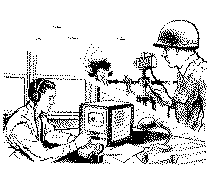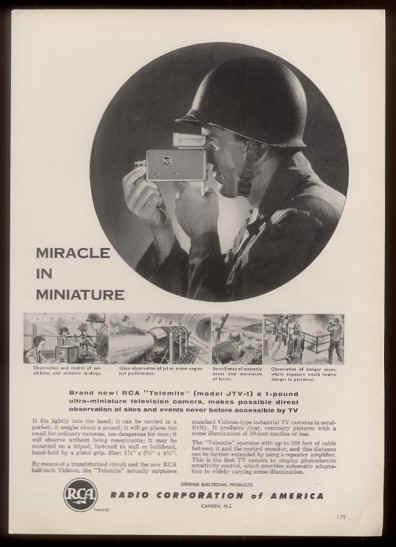|
RCA Telemite Miniature
Television Camera
(Hand-written date of July 1957 on the cover
- Wow! Early for a camera this small!)

RCA again achieves a notable advancement in the field of
television. Recognized for years as a pioneer and leader in
electronics, RCA has recently developed an ultra-miniature
(pocket-size) live-action television camera for military field,
mobile, and airborne closed-circuit TV applications.
Incorporating numerous new design and performance
characteristics, the "Telemite" TV camera represents a
significant advance in the military television art. "Telemite's"
ultra-miniature size, plus its simplicity and flexibility, will open
new fields of application for closed-circuit television. This
television camera will permit direct observation and reconnaissance
in places and locations heretofore inaccessible to existing TV
camera equipment. In mobile and airborne use, the "Telemite"
offers quality television with important savings in vital space and
power.
The smallest and lightest TV Camera in existence today
Employing transistorized circuitry and using the new RCA
half-inch vidicon pickup tube, this remarkable TV camera has been
designed for the utmost in compactness. It can be used in extremely
small or inaccessible spaces. In addition, the "Telemite"
weighs approximately one pound, is sensitive, rugged, dissipates
negligible power, and has exceptional tolerance to changes in levels
of illumination.
The "Telemite" camera may be mounted on a tripod,
fastened directly to a wall or bulkhead, or may be hand-held by a
pistol grip. In hand-held use, "Telemite" compares in size
and balance to a soldering gun or small electric drill. The "Telemite"
TV camera (model JTV-I) is designed for operation from an RCA
control monitor, type ITV-6A, slightly modified for the purpose; no
other units are required. A miniature adapter-control unit presently
under development will make it possible to use any commercial TV
receiver as a monitoring device.
Pistol-Grip "Telemite" fits lightly in the palm of
your hand
Measuring only 1%" x 2 3/8" x 4 3/4", (exclusive
of lens and grip) the complete unit can be transported readily in a
coat pocket. The "Telemite" case contains the half-inch
vidicon pickup tube with its associated focus and deflection
assembly, a transistorized pre-amplifier and blanking amplifier, and
a novel photo-electric "latitude control" . Weighing
approximately one pound, the "Telemite" will open new
avenues of military application where size and weight
characteristics are of prime consideration.
Another device under development is a minimum-size control
monitor. This monitor, by using an eight-inch rectangular kinescope
and incorporating transistorized circuitry, offers a considerable
saving in size, weight, and power consumption.
Remarkable sensitivity and resolution
This pocket-size TV camera surpasses standard vidicon-type
industrial TV cameras in sensitivity. Used with an f/1.9lens (common
on 8 mm motion picture cameras), clear pictures with good contrast
can be obtained with a scene illumination of 10 foot candles or
less. Any commercial 8 mm wide angle, normal angle or telephoto lens
can be used.
The "Telemite" TV camera operates with up to 200 feet
of cable between it and the control monitor. This distance can be
further extended by the use of a repeater amplifier. A
"slave" monitor can also be added to a system with an
intervening cable up to 2000 feet in length. Resolution equals or
exceeds that of a standard home television receiver.
Designed for maximum power economy
The "Telemite" TV system operates from a US-volt, 60
cycle AC source, and draws less than 3S0 watts. Nearly all of this
power is required by the control monitor. Only about 3 watts are
utilized by the camera itself.
Automatic compensation for changing light levels
The "Telemite" is the first TV camera to incorporate a
photoelectric sensitivity control, which automatically adjusts
certain camera circuits to compensate for widely varying values of
scene illumination. This arrangement, known as "latitude
control", allows the "Telemite" TV camera to
accommodate changes in scene lighting of the order of 100 to 1.
Rugged construction designed to withstand extreme shock and
vibration
The half-inch vidicon used in the "Telemite" camera is
physically small and mechanically simple. Its inherent ruggedness is
thus greater than that of any pickup tube heretofore available, and
the transistorized circuitry associated with it is even more rugged.
The "Telemite's" resistance to vibration and shock is very
high. For operation under unusual shock and vibration conditions
with this design, the entire contents of the "Telemite" TV
camera may be cast in potting compound or dip-coated with a
conformal coating material.
Simplicity of operation
The vidicon tube is probably the least complex to operate of any
television pickup tube. This fact is evidenced by the widespread use
of vidicon cameras in industrial, medical, educational and other
special applications, in which operation by non-technical personnel
is required. Once optical and electrical focus are set up on the
"Telemite", there are only two controls that may need
adjustment, usually in response to changes in scene illumination.
With the automatic "latitude control" of this camera, even
these adjustments will seldom be required. Considering all aspects
of military usage, the "Telemite" system will be
outstanding in its simplicity and convenience in use.
System versatility
The systems applications of the "Telemite" TV camera
are unlimited. One or more cameras can be used in connection with
many monitors. Conversely, many cameras can be used with one or more
monitors. In addition, the "Telemite" TV system can be
incorporated into existing military systems where visual observation
is required in addition to other tactical information.
A miniaturized back-pack, currently under development, will
permit completely portable, wireless operation.
A new medium for tele-observation
Since the early days of television, the many military
applications of television were apparent to our armed forces. The
development of the "Telemite" TV camera is another RCA
contribution to improve general military effectiveness. A battle
commander with this visual means can directly observe sites,
terrain, and activities otherwise inaccessible to larger existing TV
camera equipment.
Applications for the "Telemite" Television camera are
as fantastic as they are unlimited. A few examples are:
1 Battlefield surveillance from remotely-controlled drone
aircraft.
2 Location, evaluation, and designation of artillery and mortar
targets.
3 Adjustment and correction of artillery fire
4 On-the-spot portable communication between forward combat area
positions and rear echelon units.
5 Observation of blind areas in loading or docking operations
6 Close observation of jet or reciprocating engine test
performance.
7 Direct viewing of a rocket test sled or test stand operation.
8 Direct viewing of a subject animal or human being in a
centrifuge test chamber.
9 On-the-battlefield interrogation of enemy personnel
10 Observation within an atomic structure
(submarine, aircraft, reactor)
11 Reconnaissance of enemy-held territory
to monitor supply points, assembly areas, and movement of forces
12 Briefing of tactical commanders before
an action by showing terrain, maps, routes of approach, and enemy
positions
13 Observation and control of amphibious
and airborne landings, river crossings and assaults, as well as the
movement behind the lines of friendly troops and supplies.
"TELEMITE" a major accomplishment in the television
art
The "Telemite" television system offers a uniquely
compact camera of high sensitivity and ruggedness, combined with the
utmost in ease and convenience of operation. The camera can be
placed where no television camera could previously go, and can be
relied upon to perform faithfully in a wide range of conditions.
Truly, a new concept in television and miniaturization.
The "Telemite" TV camera is only one of many
outstanding television devices of comparable military value which
has been developed by RCA. Other developments include a fully
transistorized self-contained image orthicon camera chain,
specialized kinescope recorders, including the "Videostrobe"
synchronized one-shot recorder, and a variety of equipments
affording airborne television pickup with radio links to receivers
on the ground. The military television development group of RCA's
Surface Communications Department, which developed these devices, is
a highly experienced versatile team which is uniquely qualified to
adapt television techniques to military requirements.
================================================================================
================== Letter From RCA Defense Electronics Products
Below ======================
|
